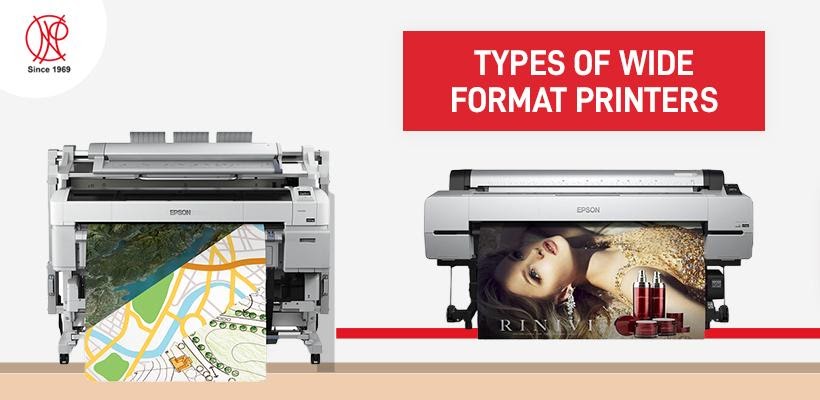Wide format digital printing has a little history compared to the print industry as a whole, as it only began at the turn of the century. Wide-format printing has advanced fast in the last 15 years, with HP and Canon jointly pioneering inkjet technology. Electrostatic technology was used in the earliest wide format printers.
As new technologies enter the market, the large format printing industry continues to evolve. The rising demand for huge prints has also aided the industry’s expansion. It takes time for ambitious large format printer entrepreneurs to grasp the constantly changing market, but fortunately, the internet today provides a wealth of information about various types of large format printers. Any computer-controlled printer or printing machine that can produce a roll spanning 18 to 100 inches is considered large.
Different types of wide format printers:
Solvent
Solvent printers are ideal for printing goods that will be in direct touch with the public or that will be used outdoors. This is because they are long-lasting, weather- and scratch-resistant, and durable. Billboards, banners, and vehicle advertisements are all common items produced with solvent printers. In addition, they are usually less expensive than inkjet printers. They do, however, create harmful fumes, so you should avoid them.
Aqueous Inkjet
The most prevalent wide format printers on the market are Aqueous Inkjet printers. Water is the carrier component of ink used in aqueous inkjet printing devices, as the name implies. According to a recent study, the market for aqueous inkjet printers will continue to increase due to digital graphics printing marketplaces and trends in technical documents. To give the fastest output, wide format printers use the highest resolution. Advertisers may extend the longevity of their posters by laminating them, and these printers are suitable for printing both outdoor and indoor materials. Fine art, photographic printing, graphic design, trade show printing, and prepress proofing are all dominated by aqueous printers.
UV based Flatbed Printers
Another new big format printing technology is UV-curable flatbed printers. UV-based flatbed printers appear to have a different ink drying mechanism than solvent-based inkjet printers. Ultraviolet rays are used in these printers to heat the curable ink and cause it to solidify on the print paper or sheet. UV-based flatbed printers have some characteristics that are nearly identical to solvent inkjet printer, but their inks are less expensive than those used in aqueous inkjet printers. Advertisers may print long-lasting outdoor images without lamination using UV-based flatbed printers.
Dry Sublimation Printers
These printers employ a dye transfer technology that allows the dye to be transferred from the print roll or sheet to fabrics, plastic, coloured Perspex, or cards. The only benefit of dye-sublimation printers is that prints dry immediately after printing. It’s a digital printing technique that works with polymer products and polyester-coated substrates and can print any colour artwork. Banners, signage, garment decoration, teacups, plaques, and cell phone covers are all printed with dye-sublimation printers. These printers employ sublimation, a process in which pressure and heat are applied to ink in a solid-state, resulting in a reaction that bypasses the liquid phase.
Latex Printers
These printers are suitable for producing long-lasting outdoor and indoor printing. Resin-based inks and latex inks, which are the most recent ink advances in the large format printing field, are used by latex printers. The water-based formulation of resin-based and latex inks, on the other hand, reduces the printing’s environmental impact. Because latex inks are water-based, further ventilation is not required. In comparison to images created with solvent inkjet printers, graphics printed with latex printers are more durable and of higher quality. Latex printers can print on nearly all of the same materials as solvent inkjet printers.
Pen Printing
It entails drawing on the print substrate using pens or a pen. The most common application of pen printing technology is the creation of CAD drawings. Digital printing technologies such as UV, aqueous, and solvent printing, on the other hand, significantly outnumber pen printing. Plotters can produce higher-quality line drawings much faster than typical printers, hence they were utilized for printing computer-aided designs.
Large interior printing
It encompasses all types of printing on posters. However, the strength and water resistance requirements for goods used in big interior printing are minimal. Advertisers who want to use their large interior printers for long-term shipping and storage should pay attention to the substrate materials and their protection. The digital era has firmly established large format printing technology. Outdoor interior designs and exterior ads are impossible to imagine without large size printing for an advertiser. Advertisers must now spend time learning about the many types of printers available before choosing a wide format printer.
Wanting to know more about wide format printing?
With this information, you should be able to figure out what kind of large format printer to search for when it comes to home or office requirements. Contact NPC for the best large format printers in the UAE.



